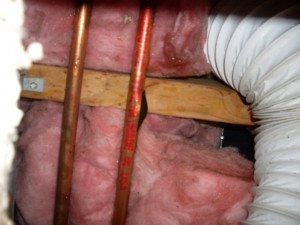Whether it’s an unexpected cold snap or an extended deep freeze, very cold winter weather can cause the water in your water pipes to freeze. The pressure of the expanding ice can rupture the pipe, releasing hundreds of gallons of water per hour and causing thousands of dollars of damage to your home or business. Expensive, messy…and easily preventable.
Frozen Pipes Prevention

Risky locations
Pipes are most susceptible to freezing when located:
• In an outside wall.
• Under a sink on an outside wall.
• In an unheated crawlspace.
There are a few things you can do to prevent the problem of freezing pipes:
- Leave the water running at a slight trickle (the size of the lead in a pencil). The dripping water will keep the water in the pipe from freezing. Be sure to have both hot and cold valves open.
- Open kitchen and bathroom base cabinets and let room air circulate.
- Open base cabinets and place a small portable heater near or in it to heat the pipes.
- Wrap the problem pipe with electrical heat tape.
- Insulate problem pipes with foam insulation wrap, especially those that run through unheated spaces.
- Temper the currently unheated crawlspace by placing a heater in the crawlspace. You just need to elevate the crawlspace temperature to modestly above freezing, about 40°F.
- Remove the hoses from your outdoor faucets, and then turn off the outside water supply at the shut off valve inside the house.
Tips on thawing frozen pipes
If a pipe bursts before it is thawed, immediately shut off the water at the water main to prevent further damage!
- Frozen but not ruptured? If you turn on the faucet and the water doesn’t come out or comes out in a trickle, your pipes are probably frozen. You need to act quickly to thaw the frozen pipe before it bursts.
- Identify the frozen water supply pipe.
- Open a faucet supplied by the frozen line, even if you have not found the frozen spot.
- To find the blockage, follow the pipe back from the faucet to where it runs through cold areas such as an exterior wall, unheated crawl space or in some cases an unheated basement if the pipe is near an outside wall.
- Often the frozen area of the pipe will be frosted or have ice on it. If the situation is getting critical the pipe may be slightly bulged or look slightly fissured.
Frozen pipe behind a wall
Leave the main water valve near your water meter open when thawing the pipe.
- If the frozen pipe is behind a wall or ceiling, you’ve got a challenge on your hands. You have three choices:
- Turn up the heat in the house and wait.
- Use an infrared lamp or lamps to heat the wall where you think the frozen area is located. Infrared lamps are better than regular heat lamps because the heat passes through the air without heating it, directing more energy to warming the wall and frozen pipe.
- Tear out part of the wall or ceiling to get at the frozen section of pipe. Then thaw the pipe as an exposed pipe.
Exposed frozen pipe
Never use a flame torch because of the fire hazard it creates. Open flame torches are the most common cause of pipe thawing related home fires.
- Heat the pipe from the faucet toward the frozen area. This way, the water can flow out as the ice melts and the water pressure in the pipe will force the ice out once it melts sufficiently.
- If the frozen pipe is exposed, you have several options.
- Hair Dryer
One of the best and safest ways to thaw the pipe is to heat the area with a high power hair dryer. Again, make sure to open the faucet and then heat the pipe working back from the faucet toward the frozen blockage. - If the pipe is close to the wall, put a cookie sheet behind the pipe to help radiate heat onto the back side of the pipe.
- Heat Lamp
A heat lamp works well to heat an exposed pipe. You can use an infrared or incandescent heat lamp. As before, if the pipe is close to the wall, use a cookie sheet behind the pipe to help reflect heat onto the pipe.
Burst Pipe Emergency
As soon as you discover a burst pipe:
Turn off the water supply
- Turn off the main water shut-off valve. You should find this in the basement or where the service pipe enters your home.
- Drain the system by turning on all your cold water valves.
Call us to repair the damage: ServiceMaster Professional Services (800) 245-4622
- We have staff on call 24/7/365. We will professionally clean and dry your home.
- Note: Electrical wiring damaged by water can be very dangerous. We can help with that.
- Note: You might need a reputable plumber to repair the burst or frozen pipe. We can help with that also.
Do what you can to collect and manage the leak. If water has been leaking through for some time and the ceilings are bulging be careful. The room may not be safe to enter.
- If you notice the leak quickly you can catch dripping water in buckets.
- Make a hole in the ceiling to let water out.
Turn off electronics/appliances
- If water leaks near your electronics or electrical appliances, switch off the breakers for each one of them immediately. If it is wet, don’t touch them!

